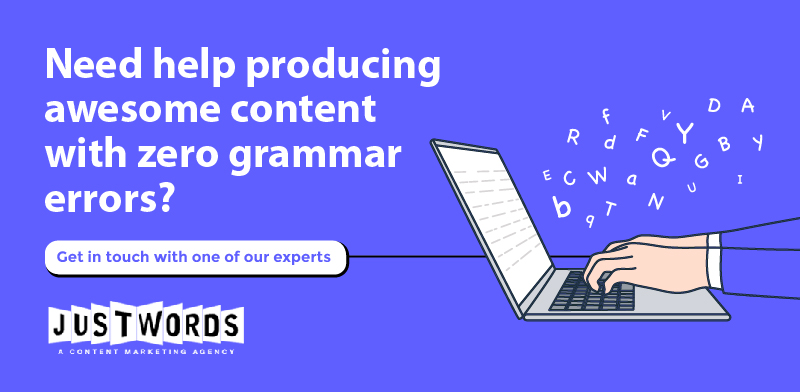Getting grammar right is one of the absolute essentials when you decide to take up content writing as a career. Oops…did a crooked red line appear under “rghit”? Luckily, Microsoft Word caught it. Still, let’s not correct it right now. We need “rghit” to show you why grammar or spelling errors can ruin an otherwise amazing piece of content (in this case, the introduction).
Though close to 1.3 billion people speak English all over the world, few can master it. Even if you are a native English speaker, being careful about common grammar errors and confusing words is helpful.
However, we understand that learning grammar from the ground up or cracking open a dictionary every time you write can be a challenge. To make matters simple, we will share handy tips or a grammar cheat sheet on how you can avoid basic mistakes with commas, and apostrophes, and use commonly confused words (like compliment and complement) correctly.
Though you can use smart tools like Grammarly or Spellcheckplus these days to catch errors, there’s nothing like the human eye. So, let’s get started with those tips.
1. To Capitalize or Not
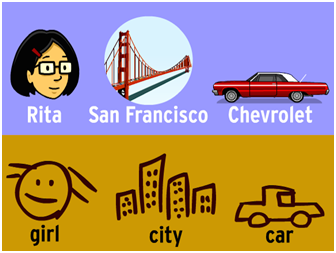
If you think that this rule only belongs to a book like ‘Grammar for Dummies’, think again! Even experienced writers tend to goof up often.
So, to clear it up, proper nouns should always start with a capital letter, be it a place, brand or someone’s name.
Example – Did you try the latest shampoo by Dove? It does wonders for my hair.
Example – Can you ask Mary to clean up in the evening?
Now, when it comes to names, don’t confuse them with the titles we usually give to our family members, like dad, mom, grandma etc. Unless the title can be replaced with a name, start with a small letter.
Example – My dad knows how to fix bikes.
Example – Annie, my sister, sings so well.
Also Read: Content Writing Tips For Beginners
2. Stay Away from Vague Pronouns
Does the sentence below sound alright to you?
“After Sonia played for almost an hour with her dog Coco, she decided to chase squirrels. “ – Who exactly decided to chase squirrels? Sonia? Not likely!
Vague pronouns can distort the meaning of a sentence and leave the reader wondering about the authenticity of the content.
The above sentence should have been crafted this way – “After playing with her for almost an hour, Sonia’s dog Coco decided to chase squirrels”.
3. The Rule for Common Abbreviations
Do you often get confused between i.e. and e.g.? Well, you are not alone.
So, we decided to keep things simple and straight in this English grammar cheat sheet:
i.e. is the abbreviation of the Latin phrase for ‘id est’, which means ‘that is’ in English.
e.g. is also derived by abbreviating the Latin phrase ‘exempli gratia’, which means ‘for the sake of example’ in English.
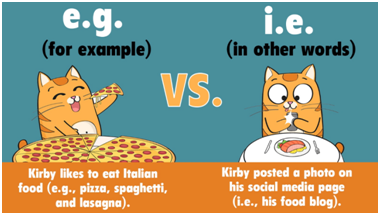
Hence, wherever you have to offer examples, use e.g.
Example – Choose from popular content formats; for e.g. case studies, blog posts, articles and e-books.
When you need to explain a sentence in detail, you should use i.e.
Example – A spider is an arthropod i.e. it belongs to the family of invertebrate animals that have exoskeletons.
4. Use Comma Only Where You Should
Using a comma before “that” is wrong as you are introducing a restrictive clause with “that”.
Wrong – The vase, that shattered on the floor was old.
Right – The vase that shattered on the floor was old.
Also, you should not use a comma to separate sentences that are independent clauses. You should use a semicolon or full stop instead.
- Wrong – Susan was looking for salad bowls, there were no shops selling them.
- Right – Susan was looking for salad bowls. There were no shops selling them.
However, if you have to connect two independent clauses, using a comma is advisable.
Wrong – After I washed the dishes I put them away.
Right – After I washed the dishes, I put them away.
5. All About Quotation Marks
No grammar rules cheat sheet is complete without this tip.
If you are writing in US English, full stops and commas should be inside quotation marks. In the case of UK English, they can be inside or outside.
Example – “It rained last night.” (As this blog post is in US English)
When you are using an exclamation point or question mark, it should be inside the quotation marks, if the tone of the quotation is exclamatory or questioning.
Example – “Do you come here often?”
Note that dashes, colons and semicolons must be outside quotation marks always.
Example (dash) – Roy said, “I like pies” – just when his friend offered him muffins.
Example (colon) – He chose his favorite book from the works of Charles Dickens: “Great Expectations”.
Example (semicolon) – Dan’s favorite quote is “Live and let live”; he uses it almost every day.
Confused about when to use double quotation and single quotation marks? Follow this rule.
Use double quotation marks while
1) Writing a standard quote or quoting another person.
2) Mentioning the name of a movie or book.
3) Indicating irony or sneering at something (like – No “good” pilot fears heights)
Use single quotation marks while
1) Using a quote within another quote. Example – The bartender said, “There was absolute silence when the customer screamed ‘This is poison!’ “
Differentiate between quote and quotation – Though many writers use quote and quotation interchangeably, they are different.
- Quote is a verb you use to quote someone, or to say what he or she said.
- Quotation is a noun used to describe whatever you are quoting.
6. Don’t Keep the Participle Dangling
A sentence like “A running man hit the pole” is an example of a sentence that uses an adjective-like participle (running). It basically tells you what the noun (man) was doing when he hit the pole.
In other words, a participle word or phrase modifies the subject in a sentence and you need to position it correctly so that the actual meaning gets conveyed.
Wrong – After being lost for months, Jay found the book under the sofa.
Right – Jay found the book that had been lost for months under the sofa.
In the wrong sentence, it seems as if Jay was lost and not the book. The participle ‘being lost’ ends up modifying the noun “Jay” instead of the book.
Also Read: A tried-and-tested guide to becoming a better content writer
7. Be Mindful of Apostrophes
Almost every writer knows why an apostrophe is used. And that is to shrink words like “it is”, “they are”, “could have” and so on. So, they become it’s, they’re and could’ve. Apostrophes are also used when you want to say that something belongs to someone.
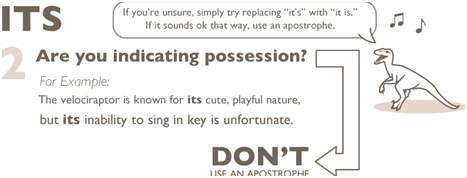
Example to show contraction – They’re best friends. (Apostrophe here shrinks the words ‘they’ and ‘are’)
Example to show possession – Rita’s car is so big. (Apostrophe here shows that the car belongs to Rita)
Also note that the use of apostrophe is slightly different when plural nouns are involved. It comes after the plural noun.
Example 1 – The dogs’ tails are similar.
Example 2 – The nurses’ chairs are blue in color.
However, many writers make the mistake of using an apostrophe where they shouldn’t. So, in this grammar reference sheet, we have used examples to clear the confusion.
For example, this is wrong – The door is tall and it’s color is red.
It should be – The door is tall and its color is red.
That is because ‘its’ means the object’s feature and not possession.
8. Should a Bullet Point End with a Period?
That totally depends on whether the bullet line is a complete sentence (use period) or a fragment (don’t use period).
Examples of bullets where you should finish with a period
The many benefits of a coffee maker include:
- You can save a lot of money by avoiding cafes.
- Brewed coffee is better for your health than instant coffee.
- You can enjoy fresh, aromatic and tasty coffee every single time.
Examples of bullets where you shouldn’t use a period
The many benefits of a coffee maker include:
- Cheaper than cafes
- More health benefits
- Fresh and tasty coffee
Fragments are just parts of complete sentences, and hence, don’t require a period at the end.
9. The Mystery of Hyphens and Dashes
This is one of those grammar tips for content writers that are usually ignored. The hyphen, en-dash and em-dash are often used casually and interchangeably, as they are quite similar. However, they have different purposes.
- Hyphen (‐) is the smallest of all three.
- En-dash (–) is longer than hyphen but shorter than em-dash. Press alt 0150 to get it.
- Em-dash (—) is the longest. Press alt 0151 or type two hyphens consecutively to get it.
A hyphen is used for making compound words or linking two or more words where the second word doesn’t seem sensible on its own.
Part-time, child-friendly, and widely known are some examples.
Hyphens – These need to be used carefully or else they might change the meaning of a sentence.
Example 1 – He is wearing a light grey shirt.
Example 2 – He is wearing a light grey shirt.
In the first example, it is evident that the color of the shirt is light grey (note how I didn’t have to hyphenate the words light and grey after the noun shirt).
In the second example, it is not sure whether the shirt is light or its color is light grey.
Hyphens are also used while writing phone numbers.
En-dash – This one is widely used for a range of pages or dates that are inclusive, like pages 50–80 or July 7–September 10, 2020. This type of dash also acts as the minus sign.
Em-dash – When you need to create a break in a sentence, this kind of dash comes in handy.
Example – We went out for Italian – and we ended up having Chinese.
Also Read: 25 things learned about content that should make you a better writer
10. Don’t Confuse between Count Nouns and Mass Nouns
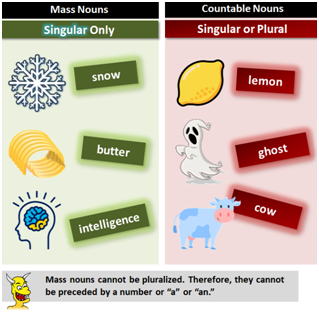
Wondering what that means? We make it clear in this grammar cheat sheet.
Consider this sentence – “There is a large amount of tomatoes on the table”. It sounds wrong…doesn’t it?
But, if you say “There are 10 tomatoes on the table”, it is correct.
This means that when a noun is countable or is a count noun, use ‘number’ to define it in a sentence. If the noun is uncountable or is a mass noun (like salt, sauce, water etc.) then use ‘amount’.
Example for count noun (dog) – There are 5 dogs in this kennel.
Example for mass noun (love) – Jane loves her children a lot.
Writers also tend to get confused between ‘less’ and ‘few’ (or fewer) as they are related to mass and count nouns respectively. Here are examples that will explain when to use what:
Less – Running to the store takes me less time than walking.
Few/fewer – I have fewer pets than my next door neighbor.
It is also important to understand the difference between much and many. While ‘many’ is used for plural nouns, ‘much’ is used for singular or collective nouns. Here are examples:
Many – Sheila has many friends.
Much – He didn’t have much to say about the incident.
11. Watch Out for Confusing Words
At times, even the most seasoned writers make mistakes when it comes to similar or confusing words that actually have different meanings. Here are some examples:
Then and Than
Then – I will first go to the store and then to the dance class. (Then is usually used to connect actions)
Than – Sam’s shirt is better than Roy’s. (Than is used for comparison)
Affect and Effect
Affect – The teacher’s words affected Joyce deeply. (Affect is used as verb)
Effect – The effect of these medicines is starting to show. (Effect is a noun)
Compliment and Complement
Compliment – Paul complimented the dress Hannah wore. (Compliment means praise or admiration)
Complement – I love the way these shoes complement my dress. (Complement means to enhance or complete something)
Lose and Loose
Lose – I don’t want to lose my purse. (Lose implies loss of something)
Loose – This skirt is very loose. (Loose is an adjective that implies not tight)
Advice and Advise
Advice – Rhea loves giving her friends advice. (Advice is used as a noun)
Advise – He advised me to invest carefully. (Advise is used as a verb)
Farther and Further
Farther – The apple farther than what he expected. (Farther is used for physical distances)
Further – If you have any further questions, ask the matron. (Further is used for abstract scenarios)
12. Tops Tools to Check Grammar
Sending an otherwise appealing email with grammar errors to your client can make a lousy impression indeed. So, we have included some smart grammar check tools in this English grammar cheat sheet to make your life simple and your sales copy flawless:
- Hemingway App – Apart from highlighting common errors, this tool helps you simplify and shorten complex and long sentences.
- Grammarly – It uses AI to spot more than 250 kinds of grammar errors, helps write clear and precise text and offers writing suggestions as well.
- Ginger Online – Write correct and better English, punctuate easily and rephrase sentences for more engagement.
- Scribens – Another efficient tool that spots spelling mistakes, corrects more than 250 types of grammar errors and even detects repetitions.
- ProWritingAid – Whether you want to better your writing style and gain insights or eliminate grammar errors, this tool can do it all.
What to Do next?
First, for quick referencing at your workplace or home office, print this grammar cheat sheet. Content writers, irrespective of their experience, won’t have to consult a dictionary repeatedly this way. Secondly, share it with others who struggle with grammar rarely or often. Thirdly, tell us what your biggest grammar pitfalls are or if you have a special tip to keep grammar errors at bay.

